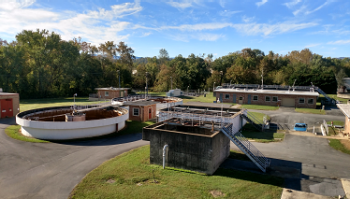Advancing Energy Efficiency in Wastewater Utilities

In 2011, the TDEC Division of Water Resources (DWR) and Office of Policy and Sustainable Practices created the Tennessee Water and Wastewater Energy Efficiency Partnership with U.S. Environmental Protection Agency (EPA) Region 4, the University of Tennessee Municipal Technical Advisory Service, the Tennessee Valley Authority (TVA), and the University of Memphis. From 2011-2015, the Partnership provided no-cost technical assistance for water and wastewater facilities to identify operational strategies that could reduce energy consumption (and, often, nutrient discharge) and result in energy cost savings.
In 2016, OEP received a U.S. DOE State Energy Program Competitive Award to continue the efforts of the Partnership and to help the State of Alabama implement a similar program. OEP began collaborating with the aforementioned Partnership members as well as with the Alabama Departments of Environmental Management and Economic and Community Affairs, to drive adoption of energy efficiency projects and technologies in the wastewater sector. During this 30-month effort, the team engaged 34 local governments in Tennessee and Alabama through free onsite energy assessments, technical workshops, and energy management implementation support.
By the end of 2018, the Partnership had assessed 41 water and wastewater systems across Tennessee (approximately 10% of the state’s plants) and Alabama and conducted 14 workshops to train operators on how to run their facilities more efficiently. The workshops highlighted financial assistance for capital improvements and featured technical presentations from U.S. EPA Region 4, TVA, the University of Memphis, and Tennessee Technological University on topics such as energy tracking, pumping efficiency, and demand response. The success of Tennessee’s energy efficient wastewater treatment program has inspired similar campaigns in Kentucky and Illinois.
The Partnership also worked directly with participating operators to identify potential energy efficiency improvements. The Partnership assessment team utilized the Bio-Tiger Model, an operations simulation tool developed at the University of Memphis, to evaluate wastewater treatment plants and to suggest low-to-no-cost operational improvements. Plants that have adopted these efficiency improvements are tracking their energy savings through the U.S. EPA Region 4’s Energy Assessment Tool. On average, implementation of these improvements has been found to reduce a system’s annual energy costs by nearly 20% and, in some cases, has reduced total nutrient discharge by 40%. Collectively, all 41 participating wastewater systems are projected to reduce nearly 12 million kilowatt hours of energy consumed per year, amounting to approximately $1,200,000 per year in cost savings. U.S. EPA and TDEC will continue to work with participating wastewater systems to collect more post-implementation energy data in the future.
Resources:
Wastewater Energy Management Toolkit: Municipal wastewater treatment systems in the U.S. consume approximately 30 billion kWh annually, and their operations are typically the largest energy users in a community. This toolkit enables water resource recovery facilities to improve their energy efficiency, providing best practices and innovative approaches successfully used by wastewater facilities to establish and implement energy management plans. It is based on the work of U.S. DOE's Better Buildings Sustainable Wastewater Infrastructure of the Future Accelerator, in which TDEC OEP was a participant.
For more information related to ongoing water and wastewater energy efficiency programming, please refer to the DWR’s Tennessee Plant Optimization Program (TN POP). For questions regarding OEP’s past water and wastewater energy efficiency programming, contact Ben Bolton, Senior Energy Programs Administrator, at Ben.Bolton@tn.gov or 615-741-2994.
Photo top left courtesy of TDEC OEP staff.